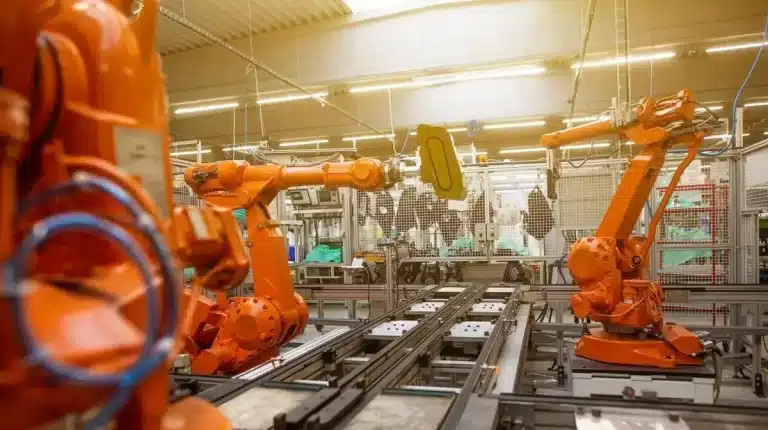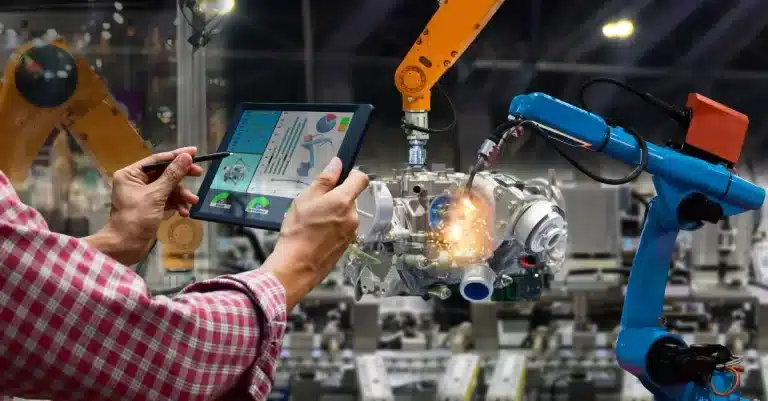The integration of artificial intelligence (AI) into cobots (collaborative robots) has revolutionized their performance capabilities.
By leveraging AI, cobots can now exhibit advanced perception and navigation skills, enabling them to accurately detect object attributes such as size, shape, orientation, and depth through 3D machine vision.
Moreover, they can safely maneuver through dynamic environments by identifying obstacles and adjusting their movements accordingly. AI algorithms further enhance cobot performance by continuously learning from data and experience.
This article explores the profound impact of AI on cobots, ranging from improved task efficiency and safety to the potential for human-cobot collaboration and expanded cognitive capabilities.
Key Takeaways
- AI enables cobots to perceive and navigate their surroundings effectively, detecting objects and responding to obstacles.
- AI-powered cobots enhance productivity by supplementing human work, performing repetitive tasks, and improving coordination between humans and robots.
- Safety features enabled by AI in cobots include built-in sensors, soft parts to prevent injuries, and context-awareness for worker’s pose and position.
The Role of AI in Cobots’ Perception and Navigation
AI plays a crucial role in enabling cobots to perceive their surroundings accurately and navigate safely by utilizing 3D machine vision, detecting objects’ size, shape, orientation, and depth, as well as detecting and responding to obstacles in their environment.
This advanced perception and navigation system greatly impacts cobot decision making, allowing them to make informed choices based on the data received from their AI algorithms.
The future of AI in cobot navigation holds significant promise, as ongoing research and advancements continue to enhance their capabilities. With the continuous development of AI technology, cobots will be able to navigate even more efficiently and effectively, making them valuable assets in a wide range of industries.
AI-powered cobots have the potential to revolutionize the way tasks are performed, leading to increased productivity, safety, and overall efficiency in various work environments.
Boosting Productivity With Ai-Enhanced Cobots
By incorporating advanced algorithms and machine learning capabilities, productivity can be significantly enhanced in collaborative robotic systems. AI-powered task optimization plays a crucial role in boosting the efficiency and effectiveness of cobots.
Through the application of AI algorithms, cobots are able to optimize their performance by analyzing data and making informed decisions. This enables them to complete tasks more quickly and accurately, leading to improved productivity.
Additionally, AI algorithms improve collaboration between humans and cobots by enabling seamless communication and coordination. This allows for smoother and more efficient workflows, as well as enhanced teamwork.
Overall, the integration of AI in cobots offers immense potential for improving productivity and collaboration, making them valuable assets in various industries.
Ensuring Safety With AI Features in Cobots
The integration of safety features enabled by advanced algorithms in collaborative robotic systems ensures a secure working environment for both humans and cobots.
Implementing AI-based safety protocols and AI-driven collision avoidance techniques are crucial for enhancing the safety of cobots.
- AI-based safety protocols: Collaborative robotic systems utilize AI algorithms to implement safety protocols that protect both humans and cobots. These protocols include real-time monitoring of the working environment, identifying potential hazards, and taking appropriate actions to prevent accidents.
- AI-driven collision avoidance techniques: AI algorithms enable cobots to detect and respond to obstacles in their surroundings. This allows them to navigate safely and avoid collisions with humans or other objects. Through advanced perception and navigation capabilities, cobots can analyze the size, shape, orientation, and depth of objects, and adjust their movements accordingly to avoid any potential collisions.
Revolutionizing Manufacturing Through AI-Enhanced Cobots
While the impact of AI in cobots is most prominently seen in manufacturing, its applications extend far beyond the factory floor.
In the realm of manufacturing, AI-enhanced cobots have ushered in a new era of efficiency and precision. These adaptable machines can perform a wide range of tasks, from intricate assembly processes to quality control inspections with unparalleled accuracy.
In manufacturing, every second counts, and AI-powered cobots deliver on this front. They excel in repetitive and time-sensitive tasks, working alongside human operators to enhance overall production speed and consistency. The result is not just increased productivity but also the potential for significant cost savings.
Manufacturers across industries, from automotive to electronics and beyond, are realizing the transformative potential of AI-enhanced cobots.
These intelligent machines can handle the most delicate operations while maintaining the highest quality standards, making them indispensable in today’s competitive manufacturing landscape.
Beyond the factory floor, AI in cobots is poised to make a mark in sectors like healthcare, logistics, and agriculture, where the benefits of enhanced efficiency and precision are equally valuable.
As technology continues to evolve, the role of AI-powered cobots in manufacturing and other fields will only become more prominent, ushering in a new era of innovation and productivity.
The Overall Benefits of AI in Cobots
Incorporating artificial intelligence into collaborative robotic systems offers a multitude of advantages. AI innovations make cobots safe, capable, and feature-filled, enabling them to work productively and safely around humans.
Ongoing AI research promises more advancements in cobot capabilities. AI technology can also be applied outside of collaborative robots, bringing peace of mind to company leaders using cobots.
Additionally, incorporating AI into cobots improves efficiency and enhances collaboration. AI-powered cobots supplement human work and improve outcomes. Mixed teams of humans and robots coordinate processes effectively.
AI algorithms enhance cobot performance with more data and experience. Cobots can perform repetitive tasks, freeing humans for more engaging work. Algorithmic planners like Act, Delegate or Learn enhance human-cobot teamwork.
Overall, the integration of AI into cobots offers numerous benefits, including improved efficiency and enhanced collaboration.
Conclusion
In conclusion, the integration of AI technology, like EasyODM machine vision software, has unlocked immense potential for enhanced performance in collaborative robots (cobots).
Through the use of EasyODM, cobots can now perform quality inspections with exceptional speed and accuracy.
Through advanced perception and navigation capabilities, cobots can accurately detect object characteristics and navigate in dynamic environments.
AI algorithms further enhance their abilities by leveraging extensive data and experience.
Moreover, cobots’ safety is ensured through built-in sensors and soft parts, mitigating the risk of injuries and damage.
As AI continues to advance, the future holds exciting possibilities for cobots and humans to work together seamlessly, resembling a synchronized dance of productivity and safety.



